by Winding Pathways | Aug 20, 2020 | (Sub)Urban Homesteading, Amphibians/Reptiles, Garden/Yard, Nature
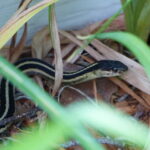
The garter snake lounges in the shade of the cool garden eating insects and worms.
On a July evening, Rich reached down to pick string beans and was startled to spot a garter snake peering up at him from beneath a plant. We’ve seen the three-foot-long snake many times this year around the yard but it seems to particularly like lounging in shade cast by bean plants.
We’re used to snakes, have no particular fear of them, and appreciate their benefits. It’s helpful that no poisonous snakes live in our area. Yet, it’s startling to see one inches from our fingers. “Our” garter snake practices social distancing and is probably more alarmed than we are with an encounter. He or she quickly vacates, letting us pick beans and tomatoes without its company.
What Do Garter Snakes Eat?
Garter snakes are common across the United States and range north into Canada. Constrictors wrap their bodies around a hapless mouse or chipmunk to eventually dispatch it. Garter snakes use a different strategy. They’re versatile carnivores and enjoy dining on insects, worms, slugs, and just about any other small enough animal to fit in their petite mouths. They quickly grab small prey and swallow whole and alive.
How Do Garter Snakes Help in the Yard?
We like our garter snake because of what it represents. If we’d doused the garden with toxic spray to kill insects, we would have no snake. Its presence signifies a healthy yard. Although garter snakes eat both beneficial and harmful insects, they probably devour many more of the latter. And, our compost-rich soil produces an abundance of worms, so the snakes can have all they want. Plenty will survive to aerate the soil.
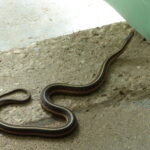
This garter snake was seeking cool shade on a hot summer day.
Startling as our snake may be, it’s as beautiful as a goldfinch or bluebird. Spotting it gives us a moment of joy. After we are done being startled.
- If having a garter snake around really troubles you, Iowa State University Extention has non-lethal ways to reduce the appeal of your yard.
by Winding Pathways | Aug 13, 2020 | (Sub)Urban Homesteading, Birds, Garden/Yard, Nature
This summer we enjoyed watching wren couples set up housekeeping at Winding Pathways. One pair nested in a small box under our porch ceiling, while another chose a box a few feet outside the dining room window.
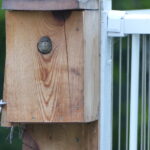
The world is big, bright and intriguing.
We watched these tiny, industrious birds make dozens of trips bringing sticks to make nests. Then, for a few weeks, we saw them infrequently. Only the female visited to lay eggs. Once her clutch was complete, she incubated them for a couple of weeks until they hatched. Then our fun began.
Wren parenting is hard work. Every two or three minutes one parent or the other brought juicy caterpillars and leggy bugs to feed the rapidly growing brood. Baby wrens hatch helpless and blind, but in just a couple of weeks, they grow almost as big as mom and dad. Finally, it’s time to fledge.
On the morning of August 9, we sat on the deck watching a young wren peer out the entrance hole, begging for breakfast. Mom or dad brought bugs, but mostly they urged the youngster, and its siblings, to take the plunge and abandon the only home they knew.
It’s scary. The nest is secure and safe. Mom and dad bring food and keep it clean. Then they expect their kids to leave and earn their own living in a world fraught with danger.
Our young wrens peered outside for a day or two before fluttering into the world. Huddling in low lying vegetation they called hungrily. Fortunately for wrens and many other birds, the adults help them out. We continued to hear these “branchers” calling in the nearby woods and caught glimpses of the parents bringing bugs to them. Slowly the babies figured it out.
After a few days, the young re-appeared around the yard, flying awkwardly. They have much to learn, and all sorts of perils to avoid. The parents continue to support them and many will wing south as the weather cools. We’ll watch for their return next April.
This year millions of American teenagers and new college grads are in the same fix as young wrens. Childhood and Youth are over. Peering out the door and knowing they must leave is scary. It’s tough enough to leave home during normal times, but this year coronavirus is making the transition extra challenging.
Young people heading for college don’t know whether classes will even be held. If so, will they be online or in-person? Will college include exposure to a virus that could sicken or kill? Recent high school and college grads seeking a job face different challenges. High unemployment and lurking viruses can make finding work difficult and, perhaps, dangerous. Join the military? Move across the country for a job? That’s perilous, also. Nothing seems safe. Everything’s confusing.
Like the young wrens, parents still help guide their offspring, providing support, advice, and encouragement as the “young” leave the nest. We send good wishes to the youthful wrens that started life at Winding Pathways and to young people about to launch into a confusing and challenging world. May they all thrive.
-
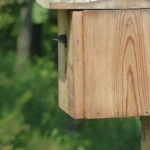
-
This baby is checking out the scenery.
-
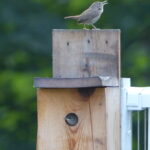
-
Parent encourages the baby.
-
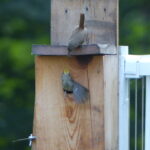
-
The parent dangles tasty morsels, forcing the baby to come outside the nest box.
-
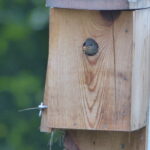
-
This huge bug is a mouthful!
-
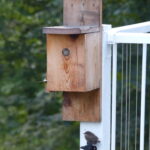
-
A short first flight.
-
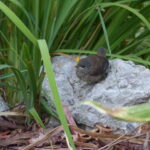
-
This wren fluttered to the ground below the next box.
by Winding Pathways | Jul 23, 2020 | (Sub)Urban Homesteading, Birds, Garden/Yard, Nature
Chickadee Delight
Guest Blogger Jackie Hull
There is nothing that can surpass the natural ebb and flow of life passing by one’s window every day. The early morning symphony of spring birds creating their own composition of sound as each species awakens to another day. The goldfinches, chipping sparrows, Indigo buntings, robins, flickers, wood thrushes, chickadees, pileated woodpecker, nuthatches, downy and hairy woodpeckers, crows, hawks, catbirds and the unflappable mockingbird all announcing to the world that it’s a new day. Up and at ‘em!”
Grand Symphony
One particular morning after this grand symphony I noticed a chickadee zip into the mimosa tree near the back door. As he teetered on a branch, he seemed to be checking out the birdhouse attached to the side picket fence that surrounds our cottage garden. The chick came in for a closer look as he landed securely on a fence post. Then straight as an arrow, he went through the birdhouse entry for the final inspection.
Apparently the abode met with approval. Soon the male and female chickadees were padding the floor of the birdhouse with moss from the woods across the pasture. Diligently they flew to and from the woods with beaks full of moss. At one point my curiosity coaxed me to peek inside the box to view their progress. The moss-covered the floor and they had begun twining fine grass strands into a circle. One of the chickadees caught me and scolded me soundly for peeking.
Mid-Day Lull
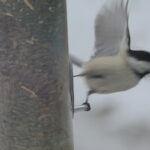
Taking wing
Mid-day that there didn’t seem to be much activity. As soon as the sun began setting, the chicks stepped up their construction. Again my curiosity pushed me to the birdhouse. I opened the door. To my complete delight, I counted six cream-colored eggs with soft brown speckles nestled in a perfectly round cup of grass. Of course, the chicks caught me again and proceeded with another scolding. I retreated to the back step.
Every day I waited impatiently for the hatching. The male came regularly with worms to share with the mate. He would give a clear whistle and then softly chat before he popped into the house. It seemed to me that this breeding process was taking too long. Once more I peeked. Six chicks opened wide their beaks and begged for food. This seemed like the last straw to the doting parents. They clamored about chattering at me. Again I retreated and watched from the back step.
Frantic Fledging
This preparing the chicks for fledging began at dawn and continued until dusk, quite a marathon. First, one adult came with beautiful green worms to be popped into the loudest mouth. The adults always announced that they were coming as they hopped from crepe myrtle to post and always bull’s eyed the doorway. As quickly as they entered, they were gone to forage for more bugs and worms.
One morning several weeks later I noticed a chick teetering in the doorway. The chick quickly retreated because that nosy woman was at the back door again. Sensing I was on the inside looking out, he hopped onto the door lip. Within a matter of minutes, he flew out the doorway, trying desperately to cling to the slippery vinyl house siding. In a twinkling of an eye, one of the adults was there to guide the fledgling to the butterfly bush. The chicks’ tail feathers were a bit short, but using every ounce of energy, the chick followed the adult across the yard into the wild rose bush.
Appreciation of Little Moments
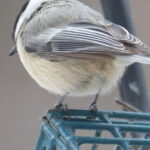
Chickadees grasp suet feeders
This was certainly a morning of the natural ebb and flow of life. If I decided to leave the back doorway, that moment would have passed me by forever. Such a glorious moment I would have missed. Within three hours the other chicks had flown away following their parents into the woods further down the lane. I could hear them chattering to the chicks and the chicks answering them. They have gone on now leaving me to ponder the wonder of life. It was a special event to have had this chickadee pair decide it was just fine to nest so near my back door.
I will always cherish the sheer joy it gave to me.
by Winding Pathways | Jul 2, 2020 | (Sub)Urban Homesteading, Garden/Yard, Nature
Prairie Seedlings
Tuesday, June 2nd was an exciting day. We walked to our 3,000 square foot patch of dirt that, until recently had been a lawn, and spotted bits of feathery green poking through the dirt. They were baby partridge peas, scattered somewhat evenly through the patch.
Last winter we decided to extend our long-term effort of transforming mowed lawn into the native prairie. In our first blogs, called Prairie Renaissance, we shared why we are doing this, early planning, and ground preparation, and seeding. You can view these on windingpathways.com. This blog tells how we manage our newly planted prairies and some of the tools we use.
Tools for Prairie Management*
*Most tools we bought ourselves. The EGO trimmer we received for testing
By far the most important “tool” for establishing a prairie is Patience. Seed a conventional lawn in the spring and it’s well established that same year. Roll out the sod and the lawn is immediate. Not so with the prairie. It needs time.
When we planted one of our first prairies in the 1980s at the Indian Creek Nature Center Jock Ingels was our mentor. His words ring true. Here’s what he said after advising us to scatter prairie seed on existing bromegrass”Plant those seeds and early next spring burn the grass. Then look carefully. You won’t see any prairie plants and think you wasted your time. Don’t give up. Burn off the grass that autumn or the next spring and watch again. You might see just a few prairie plants that year but still think you’ve wasted your time. But by the third year, the miracle starts. You’ll see more prairie plants, and it will keep getting better and better each year after.”
He was right. Planting a prairie on the existing brome is an exercise in patience. We did it because we had no money for herbicides or ground preparation. For our new prairie at Winding Pathways, we wanted to speed up the process by killing the existing lawn and baring the soil. It’s a “fast” way to start a prairie, but that’s relative. It still takes patience.
Partridge pea is a prairie sprinter. It’s an annual that shows up the first year with its pretty legume yellow bloom. Ours will bloom this summer and, if all goes well, we’ll also have Coreopsis and Black-Eyed Susans soon welcoming bees and butterflies. Newly planted prairies usually bloom with yellow flowers the first few years, while blue and red-toned flowers take longer to establish. So, we expect “yellow” in 2020 and gradually more color and species diversity as the years progress.
Planting a prairie is a little more like planting a tree than a vegetable or conventional flower garden. Patience helps.
Hands-on Tools to Help Manage Our Prairies
- Hand and battery-powered clippers to remove fast-growing weeds.
- We bought a self-propelled power lawnmower – EGO Mower. It’s quiet, effective, and inexpensive to operate.
- A battery-powered string trimmer. This allows cutting weeds higher than most lawnmowers.
- Plant identification books, especially those that have photos of seedlings and butterflies. Many books and websites help identify both prairie plants and weeds as well as insects and spiders. We recently have begun using an app called SEEK, produced by the National Geographic Society and the World Wildlife Fund. It’s free. You snap a photo of the plant, bird, insect, or fungus you want to identify and, presto, most of the time it immediately tells what it is. Many books and online resources help identify mature and blooming plants but seedlings are challenging. An outstanding guide for identifying prairie seedlings is PRAIRIE SEEDLING AND SEEDING EVALUATION GUIDE, which is available by PDF by simply Googling the publication’s name.
-
-
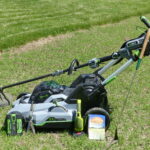
-
We use a variety of tools to manage the emerging prairie.
-
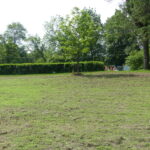
-
By early June a blush of green carpeted the upslope.
-
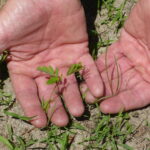
-
Partridge pea is an easy prairie plant to identify.
First Year Prairie Management
Transforming a lawn to a prairie doesn’t eliminate maintenance but it does reduce it. In its first year, a prairie needs special attention. Broadcast prairie seeds on bare ground and soon weeds march right in. In their establishment state prairie plants prioritize root growth over leaves. A rank growth of weeds can snuff them out. Young prairie plants are difficult to identify but generally hug the ground while weeds reach for the sky.
So, for the first two years, we will mow our prairie at the highest height our mower can be set at. This buzzes off the interloping weeds and lets the shorter prairie have sunlight. We’ll mow it three or four times the first year, one or two the second, and then quit mowing altogether once the prairie is established. Sometimes we use our battery-powered string trimmer to cut weeds higher than our lawnmower allows or in places where the ground is rough and the mower doesn’t work well. Future maintenance will involve burning and occasionally clipping out weeds.
Fertilizer and Water
Weeds love fertilizer. Prairie plants don’t need it. There is an irony. Over thousands of years dying prairie plants, especially their roots, created the wonderful topsoil of today’s Corn Belt, yet they do well in poor soil. We never fertilize our prairies. They just don’t need it, and if we did sprinkle some on our plantings the weeds would appreciate it and grow even faster.
The same for water. Prairies are drought tolerant. Their roots penetrate upwards of 15 feet down, drawing water from the subsoil. Watering a prairie mostly helps shallow-rooted weeds. We also completely avoid pesticides and herbicides, with the exception of killing the sod before our initial planting.
A perfect lawn needs infusions of water, fertilizer, and chemicals that stimulate so much growth that frequent mowing is needed. In contrast, a prairie doesn’t need them and, once established, needs little to no mowing.
An Excellent Resource
The Monarch Research Project is doing amazingly good work encouraging people to plant native species that make our world more beautiful and boost populations of beneficial wildlife, especially monarch butterflies. Their website is a host of information and has outstanding webinars on why and how landowners can make our earth a healthier place.
-

-
Black-Eyed Susans are biennials.
-

-
Monarch
-

-
By summer we may see Coreopsis.
Our Next Prairie Renaissance blog will be in late summer when we’ll showcase both emerging prairie plants and some of the weeds that bedevil prairies. Later in the fall, a blog will detail prairie prescribed burning.
by Winding Pathways | Jun 25, 2020 | Birds, Garden/Yard, Nature
She feeds ’em. I shoot ’em.
Guest Bloggers STB
Yes, this sounds like a love/hate relationship. But, it is truly pure enjoyment for my wife and me to witness the birds that visit our backyard feeder here in SE Minnesota.
Throughout the year a variety of birds comes from the woods to feast at my wife’s feeder. From late April to early May the orioles make their appearance. Baltimore Orioles have a vivid bright orange color and the Orchard Oriole has a noticeably darker burnt orange color. The recent reality of retirement has allowed us more time for photography and our birds have become a passion.
Capturing a static image of a perched bird is relatively easy but my goal has been to catch them in their interactions and flight. Shutter speeds of 1/1000th of a second or faster are recommended and patience is mandatory but the results might get you hooked. Beware…
-
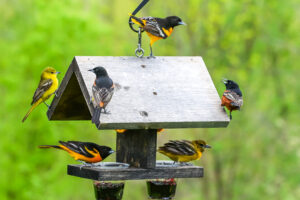
-
The jelly attracts the orioles.
-
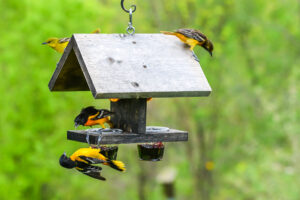
-
Sparring over rights to the jelly.
-
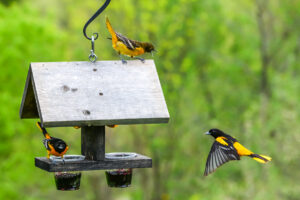
-
Warding off the in-coming oriole.
by Winding Pathways | Jun 18, 2020 | Birds, Garden/Yard, Nature
Another beautiful, blue-sky day. This early morning I am drinking tea and looking out the patio windows. As I enjoy the view of the freshly cut lawn and watch the birds flit about, a bit of busy-ness above the deck catches my attention. A small, loose clump of grey moss trembles and jerks around. It seems suspended like a little tube sock from a maple branch.
A tiny head and two bright eyes appear. In a wink, she’s gone. Moments later, another flash, this time with a hint of yellow. More trembling and jerking around, on the branch. And now I’m sure we have a nesting pair in our tree at the end of the deck.
Despite the yellow, her beak is too long and slender to be a goldfinch. A burst of warbling and I think it might be ‘Mistress Mary’, one of my favourite songbirds that keeps me company on long summer afternoons.
I can look forward to hours of entertainment.
Mistress Mary is just my name for a songbird whose phrases sound like an event organizer ordering people around:
“Jay-jay, sorry, Jo-Jo, sit here.”
“That’s your story?
“So?”
“Bring it here.”
“Will you do it?”
“Where are you?”
“Do ya think?”
She has quite a repertoire of a dozen or so phrases that she repeats faithfully. Fun to listen to. I first heard her about five years ago.
The Hermit thrush has also arrived in Eastern Canada for his summer stay. His ethereal song echoes in the woods.
Readers, scroll through the article in the New York Times to read an interesting article interspersed with bird sounds: Hear 13 Birds Flourishing in a Newly Quiet New York (City).




















